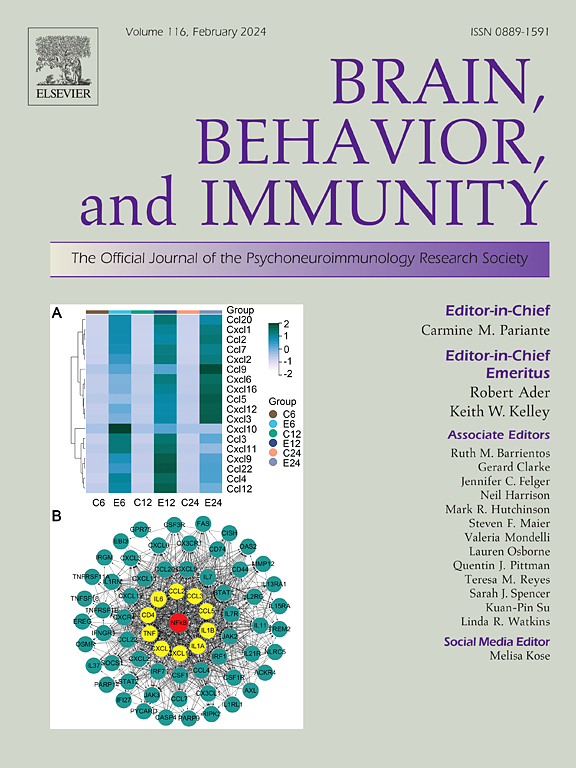Evidence of postnatal neglect-dependent resiliency in thymic, gut, and behavioral outcomes in a mouse model of early life stress
IF 8.8
2区 医学
Q1 IMMUNOLOGY
引用次数: 0
Abstract
Background
Early life is an impressionable period often regarded as the window of opportunity. Environmental exposures, such as stress, in the early postnatal period can influence developmental trajectory and long-term health. The brain and immune systems continue to develop after birth and are shaped by postnatal exposures. While chronic traumatic stress is understood to adversely affect individuals by overwhelming coping abilities, there is evidence for stress exposure to be beneficial by promoting resilience. Early life stress (ELS) is a significant postnatal exposure, which encompasses childhood maltreatment and trauma. Neglect is the most common form of maltreatment in children and takes many forms, including physical and nutritional.
Methods
Here, we describe a novel mouse model of neglect-related ELS based on maternal separation with early weaning (MSEW) with a distinct early weaning (EW) stress group to study how an environment of neglect impacts the developing microbiome, thymocytes, and stress-related behavior. Neglect-related stress was emulated based on scheduled dam-pup separation (physical neglect) and a high carbohydrate early-wean diet (malnutrition). C57BL/6J mice were bred in-house and ELS pups were subjected to: (1) daily dam-pup separation on postnatal days (PD) 2–13 and/or (2) early weaning to a high carbohydrate diet on PD14-21.
Results
The present study focused on a defined early life window (PD0-21) and revealed that MSEW versus EW exposures generate distinguishable and distinct effects on behavior and thymic T cells, leading to phenotypes of stress resilience versus vulnerability. Although impacts of the two ELS groups were indistinguishable on lower gastrointestinal tract microbiome composition, the effects on ELS groups were significant compared to controls.
Conclusions
Our findings provide evidence for circumstances where prior stress can induce resilience and emphasizes the nuanced approach required for studies to begin parsing out toxic versus beneficial stress.
在早期生活压力的小鼠模型中,胸腺、肠道和行为结果的出生后忽视依赖性弹性的证据
人生是一个易受影响的时期,常被视为机会之窗。产后早期的环境暴露,如压力,会影响发育轨迹和长期健康。大脑和免疫系统在出生后继续发育,并受到出生后暴露的影响。虽然慢性创伤压力被理解为对个体产生不利影响,因为它压倒了个体的应对能力,但有证据表明压力暴露是有益的,因为它可以促进恢复力。早期生活压力(ELS)是一个重要的产后暴露,包括童年虐待和创伤。忽视是对儿童最常见的虐待形式,有多种形式,包括身体和营养。方法在此,我们描述了一种基于母亲早期断奶分离(MSEW)和不同早期断奶(EW)应激组的忽视相关ELS的新小鼠模型,以研究忽视环境如何影响发育中的微生物群、胸腺细胞和应激相关行为。忽视相关的应激是基于预定的幼犬分离(身体忽视)和高碳水化合物的早期断奶饮食(营养不良)。在室内饲养C57BL/6J小鼠,对ELS幼鼠进行:(1)产后2 - 13天每天与幼鼠分离和/或(2)在PD - 14-21天早期断奶,饲喂高碳水化合物饲料。结果本研究聚焦于定义的早期生命窗口(PD0-21),揭示MSEW与EW暴露对行为和胸腺T细胞产生可区分的不同影响,导致应激恢复与易损性表型。虽然两个ELS组对下胃肠道微生物组组成的影响难以区分,但与对照组相比,ELS组的影响显著。我们的研究结果为先前的压力可以诱导恢复力的情况提供了证据,并强调了开始分析有害压力与有益压力所需的细致入微的方法。
本文章由计算机程序翻译,如有差异,请以英文原文为准。
求助全文
约1分钟内获得全文
求助全文
来源期刊
CiteScore
29.60
自引率
2.00%
发文量
290
审稿时长
28 days
期刊介绍:
Established in 1987, Brain, Behavior, and Immunity proudly serves as the official journal of the Psychoneuroimmunology Research Society (PNIRS). This pioneering journal is dedicated to publishing peer-reviewed basic, experimental, and clinical studies that explore the intricate interactions among behavioral, neural, endocrine, and immune systems in both humans and animals.
As an international and interdisciplinary platform, Brain, Behavior, and Immunity focuses on original research spanning neuroscience, immunology, integrative physiology, behavioral biology, psychiatry, psychology, and clinical medicine. The journal is inclusive of research conducted at various levels, including molecular, cellular, social, and whole organism perspectives. With a commitment to efficiency, the journal facilitates online submission and review, ensuring timely publication of experimental results. Manuscripts typically undergo peer review and are returned to authors within 30 days of submission. It's worth noting that Brain, Behavior, and Immunity, published eight times a year, does not impose submission fees or page charges, fostering an open and accessible platform for scientific discourse.

 求助内容:
求助内容: 应助结果提醒方式:
应助结果提醒方式:


